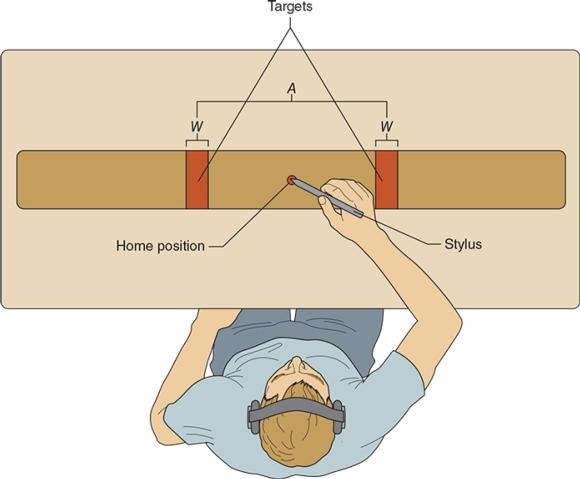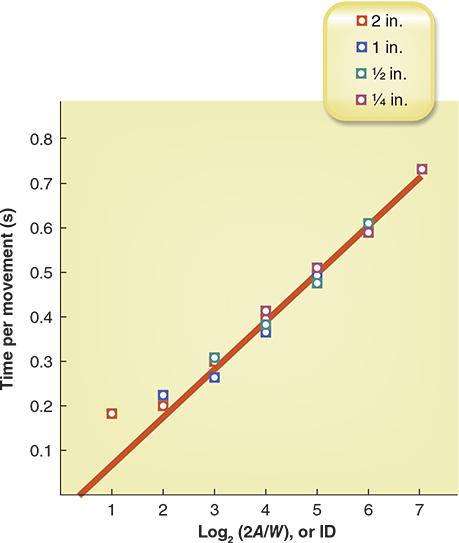Understanding Fitts' Law
This is an excerpt from Motor Learning and Performance 6th Edition With Web Study Guide-Loose-Leaf Edition by Tim Lee & Richard Schmidt.
Fitts' Law
Fitts used a paradigm in which the participant tapped alternately between two target plates as quickly as possible. The separation between the targets (termed A, for movement amplitude) and the width of the targets (termed W, for target width) could be varied in different combinations (see figure 6.1). The movement time (MT) taken to complete these rapid taps increased systematically with either increases in the movement amplitude (due to a larger distance between the targets) or decreases in the target width (due to a smaller target-landing area). These relationships were combined into a formal mathematical statement that is now known as Fitts' Law (see Focus on Research 6.1).

Figure 6.1 Illustration of a participant performing a Fitts tapping task. The participant taps between two targets of varying width (W) and with varying amplitude between them (A), attempting to move as rapidly as possible while keeping the number of target misses to a minimum.
Fitts' Law states that MT is constant whenever the ratio of the movement amplitude (A) to target width (W) remains constant. So, very long movements to wide targets require about the same time as very short movements to narrow targets. In addition, Fitts found that the MT increased as the ratio of A to W increased by either making A larger, making W smaller, or both. He combined these various effects into a single equation:
MT = a + b [Log2(2A/W)]
where a (the MT-intercept) and b (the slope) are constants, and A and W are defined as before. The relationships between A, W, and MT are plotted in figure 6.2 for one of Fitts' data sets. The term Log2(2A/W) is referred to as the index of difficulty (abbreviated ID), which seems to define the difficulty of the various combinations of A and W. Therefore, Fitts' Law says that MT is linearly related to the Log2(2A/W), or simply, that MT is linearly related to the index of difficulty (ID).

Figure 6.2 Average movement time (MT) as a function of the index of difficulty (ID).
Focus on Research 6.1
The Fitts Tasks
In his most well-known experiment, Fitts (1954) asked participants to make movements of a handheld stylus between two target plates. In this task, which is now typically known as the Fitts tapping task (see figure 6.1), the widths (W) of each target and the amplitude (A) between the targets were varied in different combinations, and the participant's goal was to alternately tap each target as quickly as possible while making as few errors as possible (missed targets < 5%). The experimenter would measure the number of taps completed in, say, a 20 s trial, and then compute the average time per movement, or movement time (MT).
However, this target-tapping paradigm was not the only way that Fitts studied rapid aiming. Figure 6.3 illustrates two other tasks used in Fitts (1954) research. In figure 6.3a, the participant's task was to move small metal discs with holes in the center (like carpenters' washers) from one peg to another. In figure 6.3b, the task was to move small pins from one hole to another. In both of these task variations, Fitts redefined target width (W) in terms of the tolerance between the discs and target pegs (figure 6.3a) or the diameter of the holes in the plate in relation to the diameter of the pin (figure 6.3b). With ID defined in this manner, Fitts found that the same equation—MT = a + b (ID)—held well in accounting for the effects of the task parameters of movement speed.
How do all of these experimental tasks converge to define Fitts' Law? The first part is easy—amplitude is the distance-covering portion of MT and is common to each task. The effect of target size is more complicated. In the aiming task, this is essentially just target width. However, in the disc-transfer (figure 6.3a) and pin-transfer tasks (figure 6.3b), the target size is operationalized as the difference between sizes of the object and the target. For example, in the pin-transfer task, a large hole only represents an easy ID if the pin being inserted is relatively narrow. If the pin is wide, then the task becomes more difficult because there is less tolerance for error. Thus, all three of these tasks converge upon the central problem of the speed-accuracy trade-off—how the task parameters cause the participant to vary MT in order to make the end product of the aimed movement accurate.

Figure 6.3 Alternative reciprocal-movement tasks used by Fitts (1954): (a) disc-transfer task, (b) pin-transfer task.
Exploring Further
What would be the ID for a tapping task that had W = 4 and A = 16?
What changes in the foot's travel time from the accelerator to the brake pedal would you expect to see if you doubled the size of the brake pedal?
An important point is that Fitts' Law describes the tendency for performers to trade speed for accuracy. In what has now become the typical Fitts tapping task, participants are told to minimize the number of target misses. In other words, they are instructed to adjust MT so that the errors are acceptably small. Thus, when the target size is increased, the accuracy requirements are relaxed and MTs are smaller than when narrow targets are used. This has led to the general notion of a speed-accuracy trade-off—the tendency for people to sacrifice or trade off speed in order to maintain acceptable levels of accuracy—as one of the most fundamental principles of movement behavior.
Fitts' Law, which describes MT as a function of the movement distance and the accuracy requirements of a task, has been found to hold under many different environmental conditions (e.g., tapping underwater or in outer space), for many different classifications of people (e.g., children, older adults, individuals with neurological impairments), and for movements made with different effectors (e.g., handheld, foot-held, head-mounted pointing devices) (see Schmidt et al., 2019; Plamondon & Alimi, 1997). Fitts' Law also applies to how movement speed is controlled in many tasks of everyday living (see Focus on Application 6.1).
The movements studied with the Fitts tapping task are almost always blends of programmed actions with feedback corrections added near the end to land on the target. That is, in these movements the performer generates a programmed initial segment of the action toward the target, probably processes visual feedback about the accuracy of this action during the movement, and initiates one (or sometimes more) feedback-based corrections to guide the limb to the target area (Elliott et al., 2017). As discussed in chapter 4, such visual compensations are probably processed through the dorsal visual stream and might not be controlled consciously. Thus, Fitts' Law describes the effectiveness of the combined open- and closed-loop processes that operate in these common kinds of actions, where potentially all of the open- and closed-loop processes shown in the conceptual model in figure 4.10 are operating together.
Finally, it is reasonable to suspect that slower movements are more accurate, at least in part, because there is more time available to detect errors and to make corrections (as discussed in chapter 4), and that MT lengthens when the number of corrections to be made increases. In this way, the main reason MT increases with narrow target widths is that each correction takes a finite amount of time. Meyer and colleagues (1988) and Elliott et al. (2017) have developed formal models of the processes involved in the speed-accuracy trade-off that extends our understanding of Fitts' principles.
Wishing to extend their ideas to tasks that are more typical and realistic, Fitts and Peterson (1964) used the same idea and variables as in the reciprocal-tapping task (figure 6.1), but used them with movements in which a single action was required from a starting position to a single target. Similar to the reciprocal-tapping task, these targets were located various distances (A) from the starting position and were of different sizes (W). Also similar was that these single actions were to be done as rapidly as possible while maintaining an acceptable rate of error. The independent variables A and W and the dependent variable MT were related to each other in essentially the same way as they were in the reciprocal task. That is to say, the equation for Fitts' Law also applied to the single-movement paradigm, which increases our confidence that Fitts' Law is one of the truly fundamental laws of motor behavior.
In brief, Fitts' Law tells us the following:
- Movement time (MT) increases as the movement amplitude (A) increases.
- MT increases as the aiming accuracy requirement increases, that is, as target width (W) decreases.
- MT is essentially constant for a given ratio of movement amplitude (A) to target width (W).
- These principles are valid for a wide variety of conditions, participant variables, tasks or paradigms, and body parts used.
However, a number of other questions remained unanswered. What about movements that are completed in a very short period of time, where presumably no feedback is involved during the movement? How can MT depend on the number of corrections when there is not enough time to make even a single correction? Some of these questions are answered in the next section.
SHOP

Get the latest insights with regular newsletters, plus periodic product information and special insider offers.
JOIN NOW


